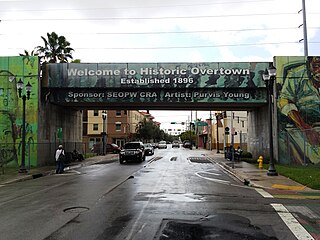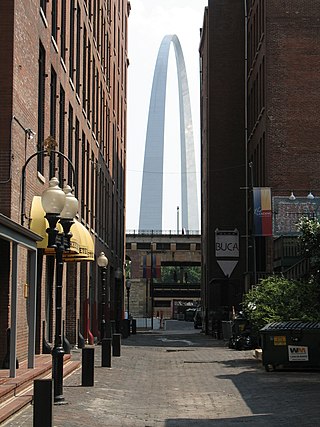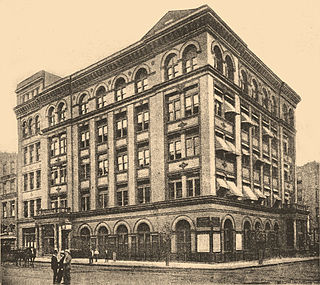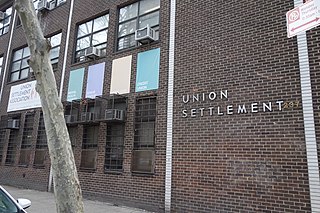
East St. Louis is a city in St. Clair County, Illinois. It is directly across the Mississippi River from downtown St. Louis, Missouri, and the Gateway Arch National Park. East St. Louis is in the Metro-East region of Southern Illinois. Once a bustling industrial center, like many cities in the Rust Belt, East St. Louis was severely affected by the loss of jobs due to the flight of the population to the suburbs during the riots of the late 1960s. In 1950, East St. Louis was the fourth-largest city in Illinois when its population peaked at 82,366. As of the 2020 census, the city had a population of 18,469, less than one-quarter of the 1950 census and a decline of almost one third since 2010.

Roxbury is a neighborhood within the City of Boston, Massachusetts, United States.

The Henry Street Settlement is a not-for-profit social service agency in the Lower East Side neighborhood of Manhattan, New York City that provides social services, arts programs and health care services to New Yorkers of all ages. It was founded under the name Nurses' Settlement in 1893 by progressive reformer and nurse Lillian Wald.
New Community Corporation (NCC) is a not-for-profit community development corporation based in Newark, New Jersey. NCC focuses on community organizing, provision of a variety of community-enhancing services, and resident participation in agency operation. Early prototypes of the community action movement included local housing and service agencies started by the Ford Foundation Gray Areas Initiative and the United States Office of Economic Opportunity, and both federal and private Mobilization for Youth in New York City.

Overtown is a neighborhood of Miami, Florida, United States, just northwest of Downtown Miami. Originally called Colored Town in the Jim Crow era of the late 19th through the mid-20th century, the area was once the preeminent and is the historic center for commerce in the black community in Miami and South Florida.

Downtown St. Louis is the central business district of St. Louis, Missouri, the hub of tourism and entertainment, and the anchor of the St. Louis metropolitan area. The downtown is bounded by Cole Street to the north, the river front to the east, Chouteau Avenue to the south, and Tucker Boulevard to the west. The downtown is the site of many corporate headquarters, including Stifel Financial Corp., HOK, Spire Inc, and a host of other companies.

Lugenia Burns Hope, was a social reformer whose Neighborhood Union and other community service organizations improved the quality of life for African Americans in Atlanta, Georgia, and served as a model for the future Civil Rights Movement.
The Venice Community Housing Corporation (VCHC) was formed in 1988 by a group of grassroots activists who were interested in preserving affordable housing in the Venice neighborhood of Los Angeles, California, United States. Since that time, VCHC has grown to a comprehensive community development corporation with family support programs, gang prevention programs, job training and affordable housing.
Hamilton-Madison House is a voluntary, non-profit settlement house dedicated to improving the quality of life of its community, primarily that of the Two Bridges/Chinatown area of the Lower East Side of Manhattan, New York City, United States. The neighborhood is a federally designated poverty area, with a constantly changing mixture of ethnic groups, and lack of adequate services and resources. An average income of a family living in the area is $17,000. Further, more than 25% of the seniors live on less than $15,000 a year, of which 40% goes toward housing. In the past 108 years, Hamilton-Madison House has developed programs that meet the changing needs of its community. In 1965, with a change in federal immigration policies, the community's predominant immigrant became Chinese New Yorkers. Since that time, the organization's staff has grown to include a staff of 300 who collectively speak 15 languages, including 6 Chinese dialects. Further, the House's long-standing programs have been adapted to meet the cultural norms of this expanding population.

Educational Alliance is a leading social institution that has been serving communities in New York City’s Lower Manhattan since 1889. It provides multi-generational programs and services in education, health and wellness, arts and culture, and civic engagement across 15 sites and a network of five community centers: the 14th Street Y, Center for Recovery and Wellness, Manny Cantor Center, Sirovich Center for Balanced Living, and Educational Alliance Community Schools.

College Hill is a neighborhood of the City of St. Louis, Missouri. The name College Hill was given to this area because it was the location of the Saint Louis University College Farm. This area, bounded generally by Warne Ave., O'Fallon Park, I-70, Grand Boulevard, and W. Florissant Ave., was acquired by the University for garden and recreation purposes in 1836. It was subdivided in the early 1870s.
Elm Thicket is a primarily residential neighborhood in North Dallas, Texas near Love Field airport and the neighborhoods of Love Field, Bluffview, Greenway Parks, University Park and Highland Park.

Southern Illinois University School of Dental Medicine is an academic unit of Southern Illinois University Edwardsville (SIUE) located in Alton, Illinois, United States, in the Greater St. Louis area. The school is one of three dental schools in the state of Illinois and is mandated with the mission "to improve the oral health of the people of Southern Illinois and the region through education, patient care, scholarship and service".

Union Settlement is one of the oldest settlement houses in New York City, providing community-based services and programs that support the immigrant and low-income residents of East Harlem since 1895. It is East Harlem’s largest social service agency and serves 10,000 people annually through programs including early childhood education, youth services, senior services, adult education, mental health, small business development and community outreach.

MorningSide is a neighborhood on the east side of Detroit, Michigan. The area is bounded by Harper Avenue and Interstate 94 on the north, Mack Avenue to the south, East Outer Drive and Whittier on the east and Alter Road and East Outer Drive to the west. The local association that shares the name MorningSide with the community is a collaboration of residents working together to take care of this area.

Founded in 1965, the Chinese-American Planning Council, Inc. (CPC) is one of the largest non-profit providers of educational, social, and community services for Asian-Americans in the United States. It now services over 8,000 people daily through some 50+ programs at over 30 locations citywide. It administers early childhood, school-age child care, youth, community, workforce development, and senior services. Its mission is to serve the Chinese-American, immigrant, and low-income communities in New York City by providing services, skills, and resources towards economic self-sufficiency.
La Alianza Hispana is a social service agency founded in 1969 by residents of Roxbury/ North Dorchester to support Boston's Hispanic population. La Alianza advocates for equal access to services and public resources for the Hispanic Community by combating the effects of discrimination, poverty and challenges of migration.

Woman's Foreign Missionary Society of the Methodist Episcopal Church was one of three Methodist organizations in the United States focused on women's foreign missionary services, the others being the WFMS of the Free Methodist Church of North America and the WFMS of the Methodist Protestant Church.
The Houchen Settlement House was founded in 1912 in El Segundo Barrio in El Paso, Texas.
Neighborhood House may refer to:


















